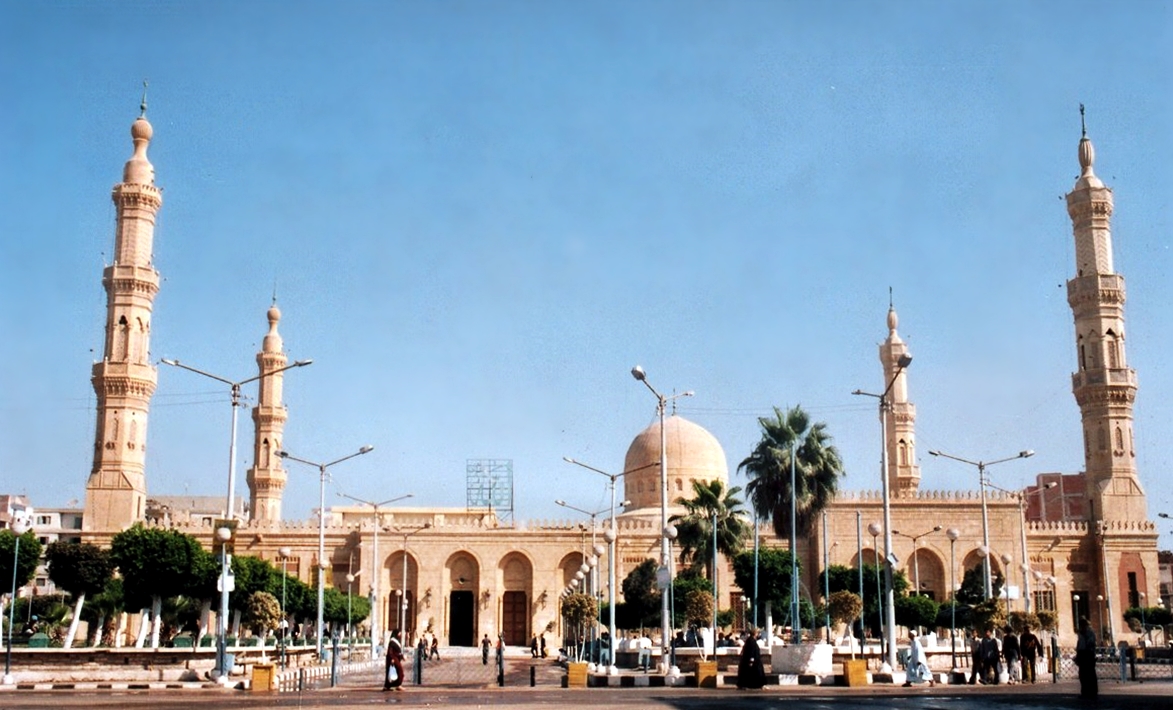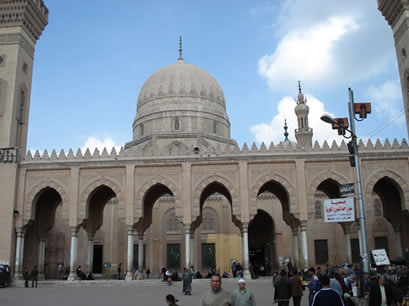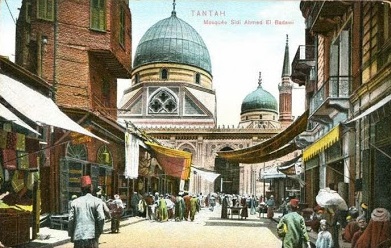Bio: Sh. Ahmad al-Badawi
Sh. Ahmad al-Badawi
سيدي الشيخ أحمد ابدوي
d. 675 H. in Tanta, Egypt
radiya Allah anhu
.
English
2. Letters (from Aisha Bewley’s homepage external links: [1] [2] [3]
3. Biographical note from dar-sirr.com (see below)
The second most widespread Sufi order in Egypt after the Shadhiliya order, founded by the Moroccan sharifian Shaykh Sidi Abul Hassan Shadhili (d. 656/1241), is that of the Badawiya Brotherhood, founded by another Moroccan, the most popular luminary in Egyptian Sufism, the Rifaite master Sidi Ahmed Badawi al-Fasi. His disciples in Egypt number in hundreds of thousands, and the main religious festival (mawlid) held in his honour each year in the Nile Delta city of Tanta, where he lived and died, attracts more than two million Egyptians. Shaykh Sidi Ahmed Badawi al-Fasi, whose family had emigrated from Fez to the East, spent his youth in Mecca among the bedouin and won a reputation as a daring horseman and courageous knight. While still a young man, he experienced a spiritual transformation, devoting himself to the transformation and to meditation. Sidi Ahmed al-Fasi travelled to southern Iraq, where he received training in the way of the Rifaiya, named after the Hassanid sharif Sidi Ahmed Rifai (d. 678/1236), at the hand of great master Sidi Ahmed ibn Ali Rifai. Sent to Egypt by his master upon the death of the Rifaiya representative in Egypt, Sidi Ahmed al-Fasi settled in Tanta and quickly acquired a large following that ranged from vast numbers of ordinary Egyptians to Mamluk amirs. The Mamluks were the newly empowered slave rulers of Egypt, who were to reign in Cairo and serve as patrons and protectors of one of the most glorious phases of Islamic civilisation for more than four hundred years. The Mamluks almost invariably allied themselves as a ruling establishment to the Sufi orders as institutions out of personal conviction and a quest for legitimacy. Sufism was not simply a popular religious attitude to be supported, but I many cases a spiritual discipline to be persuaded personally. Sidi Ahmed al-Fasi lived in Tanta for forty-one years, during which time he received divine permission (idhn) to establish his own order independent of the Rifaiya. Many miracles have been attributed to him, before and after his death, as a vehicle for God’s grace (fadl), and he is viewed as one who may intercede in heaven for the ordinary believer.
عربي
2. From Kuhin: Tabaqat al-Shadhiliyya: View book | Download | Chapter [8] (see below)
(…- 675)
الأستاذ الصالح العارف المجذوب، الشارب في المحبَّة من صافي المشروب، بحرُ الفتوح، وساكن السطوح، ذو السرِّ الممنوح، والكرامات العديدة، والإشارات المديدة، الأستاذ الفتى، ساكن طندتا، من لذكره في الأسحار دوي، أبو العباس سيدي أحمد البدوي، فارسُ الأولياء بالديار المصرية والجزائرية القبرصية، المعروف بالأستاذ أبي الفتيان الحسيني النسب، الطاهر الحسب، العلوي الملثَّم، المعتقدُ المعروف المشهور، عُرف بالبدوي لكثرةِ ما كان يتلثَّمُ.
مولده بفاس حرسها الله من كلِّ باس.
وحجَّ أبوه وهو صحبته، فتُوفي في مكَّة، فبقي سيدي أحمد وإخوته، فنشأ بمكَّة وتربّى بها، وعرض عليه أخوه التزويج فامتنع، ثم حَدَثَ له حالٌ في نفسه، فتغيَّرت أحوالهُ، واعتزل الناس، ولزم الصمت، وكان لا يتكلم إلا بالإشارة، ثم قيل له في منامه: أنْ سِرْ إلى طندتا، وبُشِّرَ بحال يكون له. فسار هو وأخوه الشريف حسن رحمه الله تعالى، فدخلا العراقَ وبغداد، وعاد الشريف حسن إلى مكّة، وتخلَّفَ سيدي أحمد، وسار إلى طندتا مسرعًا إلى دار سيِّد البلد، وصَعِدَ إلى السُّطوح، وصارَ يصيح، ويُكثر في الصياح.
وكان يَطوي أربعين يومًا لا يتناول فيها طعامًا ولا شرابًا، وهو شاخصٌ ببصره إلى السماء.
ومكثَ قدّس الله روحه على السُّطوح اثني عشر عامًا.
وحجَّ وزار جدَّه رضى الله عنه، ولما وقفَ تجاه الروضة المطهَّرة أنشأ يقول:
| إنْ قيل زُرتم بما رجعتم | * | يا أكرمَ الرُّسل ما نقول |
فردَّ عليه المصطفى صلى الله عليه وسلم بحضرةِ الشهود:
| قولوا رَجعنا بكلِّ خيرٍ | * | واجتمع الفرعُ بالأُصول |
إلى آخر القصيدة المعروفة المتداولة بين الصوفية.
كانت صفته رضى الله عنه أكحلَ العينين، طويلَ الذِّراعين، كبيرَ الوجه، طويلَ القامة، قمحي اللون، أقنى الأنف([2])، على أن فيه شامتين.
له كراماتٌ مشهورة، شُهرته تغني عن التعريف عنه، وله أصحابٌ كثيرون، وشطحاتٌ ومشاهدات.
توفي رضى الله عنه يوم الثلاثاء اثني عشر ربيع الأول سنة خمسٍ وسبعين وست مئة، ودُفن بمقامه المعلوم. نفع الله به، وأمدّنا بمدده. آمين.



